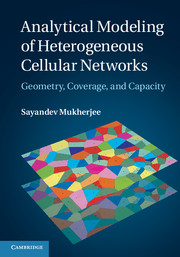Book contents
- Frontmatter
- Contents
- Preface
- Acknowledgemants
- List of notation
- List of acronyms and abbreviations
- 1 Introduction
- 2 Structure of the SINR calculation problem
- 3 Poisson point processes
- 4 SINR analysis for a single tier with fixed power
- 5 SINR analysis for multiple tiers with fixed powers
- 6 SINR analysis with power control
- 7 Spectral and energy efficiency analysis
- 8 Closing thoughts: future heterogeneous networks
- Appendix A Some common probability distributions
- Appendix B HCNs in LTE
- References
- Author index
- Subject index
6 - SINR analysis with power control
Published online by Cambridge University Press: 18 December 2013
- Frontmatter
- Contents
- Preface
- Acknowledgemants
- List of notation
- List of acronyms and abbreviations
- 1 Introduction
- 2 Structure of the SINR calculation problem
- 3 Poisson point processes
- 4 SINR analysis for a single tier with fixed power
- 5 SINR analysis for multiple tiers with fixed powers
- 6 SINR analysis with power control
- 7 Spectral and energy efficiency analysis
- 8 Closing thoughts: future heterogeneous networks
- Appendix A Some common probability distributions
- Appendix B HCNs in LTE
- References
- Author index
- Subject index
Summary
Introduction
In Chapters 4 and 5, we analyzed the distribution of the SINR at a user in single-tier and multi-tier deployments, respectively, when all BSs in each tier transmitted with the same, fixed, power. This is a good model for the pilot channels in a system such as LTE, because the pilot channels are used by the UEs to identify BSs, and it makes sense for the power in these pilot channels to be as high as possible all the time. We also know that the distribution of maximum SIR (without selection bias) in an interference-limited deployment is not a function of the (assumed fixed) transmit powers in the tiers if either (i) there is a single tier (see (4.74)), or (ii) the path-loss exponents are the same in all tiers and all tiers are open (see (5.60)).
If serving BS selection is made after applying selection bias (usually in order to modify the loading of the tiers in some way), we know that overall coverage is not the same as with the max-SINR selection criterion without bias (see Remark 5.6). In fact, some users may suffer from poor SINR due to interference from the tier that would have served them in the absence of selection bias, as discussed in Section 5.4. In these circumstances, operating the system at the desired level of performance calls for interference control, usually realized by means of transmit power control (or just power control, for short) with different levels of coordination across BSs, both in a tier and across tiers.
- Type
- Chapter
- Information
- Analytical Modeling of Heterogeneous Cellular NetworksGeometry, Coverage, and Capacity, pp. 122 - 140Publisher: Cambridge University PressPrint publication year: 2014



